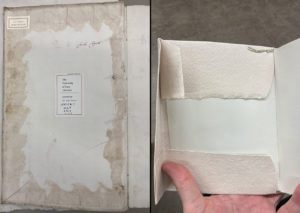By Beth Stone, MFA
Collections Conservator, University of Iowa Libraries
When volumes arrive in conservation, the first step is a quick assessment. Often this entails physical inspection of a cart of 30-80 items, ticking off from a checklist of the most common repairs or housings we provide. When an individual item is shuffled to a technician’s bench, a more thorough assessment can be completed. At first pass, I had put this item into a queue needing more intensive repair. The binding had become disengaged from the textblock, and though it looked otherwise sound, I set it aside to tackle at a future date.
 It’s always delightful when an Italian paper binding comes into the lab for some treatment. They are a pleasure to hold and often have some quirks. Paper bindings were common in Italy from the early sixteenth century through the early nineteenth century. This Morgagni is an example of one of the two main types: a laced-case binding. For non-binders, this means the textblock was sewn onto alum taw (a white leather) supports, which were then laced through the single-piece heavy paper cover.
It’s always delightful when an Italian paper binding comes into the lab for some treatment. They are a pleasure to hold and often have some quirks. Paper bindings were common in Italy from the early sixteenth century through the early nineteenth century. This Morgagni is an example of one of the two main types: a laced-case binding. For non-binders, this means the textblock was sewn onto alum taw (a white leather) supports, which were then laced through the single-piece heavy paper cover.
Paper bindings served two purposes; they were either placed on a textblock for temporary protection, assuming that the owner would eventually pay to have a more distinguished binding, or intended to be a less expensive final binding. It can be difficult to tell what the intention was. In this particular volume, the pages were never trimmed, and the rippling edges are the result of the deckle (wooden frame) of the paper mould (screen). These edges would have been trimmed to be flush and perhaps decorated in a different binding.
Additionally, the single-layer paper cover has no reinforcement. It remains very flexible on a book of this size while very thin and still protective. However, I think this may have originally been intended as a temporary measure rather than a final binding. The large size of the volume (10.25 in x 16.14 in) would likely require more substantial binding for handling, which would have cost a hefty sum. Additionally, the printing style seems to demand a more decorative binding.
Upon closer inspection, I noticed that the taw thongs were cleanly cut at the textblock. The thongs also remained intact on the rear cover and under the paste down. Though removing a portion of the textblock resulted in a spine that was now too wide for the text that remained, no damage was present on the paper cover. Since it was paper, the cover had been able to naturally refold itself and conform to the smaller size of the spine.
 There were a handful of documents stuck in the text. Among them was a note from the purchase by Dr. Martin. It indicated that the item had been received by him, and then later by the library, in this condition.
There were a handful of documents stuck in the text. Among them was a note from the purchase by Dr. Martin. It indicated that the item had been received by him, and then later by the library, in this condition.
Ultimately, this item will get custom housing [storage box] and return to the collection without any intensive treatment. I will clean the cover – using specialized sponges and perhaps a gel for the stained corner – but the sewing will remain broken, and the textblock will remain disengaged.
